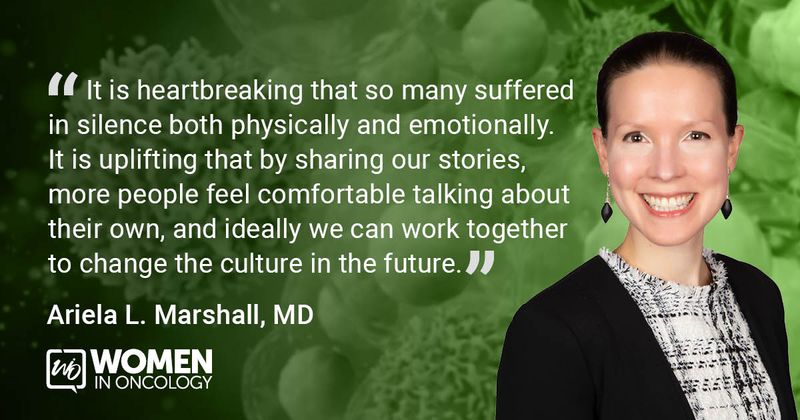Female hem/oncs seek to raise awareness of physician infertility
Click Here to Manage Email Alerts
Long work hours, demanding training during reproductive years and overall stress may lead some physicians to delay their plans to start a family.
When physicians do decide to begin that journey, a larger-than-expected proportion are faced with the challenges of infertility.

“I never pictured that I would struggle with infertility, especially because my mother gave birth to me at 40, so I didn’t think I would have difficulties building a family in my 30s,” Ariela L. Marshall, MD, a hematologist at Penn Medicine and curriculum chair at American Medical Women’s Association (AMWA) IGNITE, said in an interview with Healio. “I assumed that having a child at age 34 or 35 would not be an ‘issue.’ So to find after trying for over a year that I was not able to have a child ‘naturally’ was hard to accept.”
According to a “Call to Action” commentary published in Academic Medicine, authored by Marshall and colleagues, infertility is more common among female physicians, than women in the general U.S. population, at around 25% compared with 9% to 18%.
Yet the phenomenon of infertility among female physicians has not been extensively studied, and the issue of infertility among male physicians has not been studied at all.
To address the problem of physician infertility, Marshall was involved in launching an Infertility Task Force for AMWA. The association held its first Physician Fertility Summit in June, and during the summit discussed topics such as fertility assessment and infertility treatment, mental health issues related to fertility, benefits and coverage and advocacy in family building.
“The stories I have heard from other women physicians about their infertility journeys have been both uplifting and heartbreaking,” Marshall said. “It is heartbreaking that so many suffered in silence both physically and emotionally. It is uplifting that by sharing our stories, more people feel comfortable talking about their own, and ideally we can work together to change the culture in the future.”
Multiple challenges
No single cause has been identified for infertility among female physicians, but research has begun to investigate the topic.
A 2016 survey study authored by Reshma Jagsi, MD, DPhil, and colleagues assessed infertility rates among 600 female physicians who graduated medical school between 1995 and 2000. Respondents reported an average age of 27.5 years at medical school graduation, 31.6 years at completion of medical school and residency and 30.4 years at first pregnancy.
Almost a quarter (24.1%) of respondents who had tried to conceive were diagnosed with infertility, with an average of diagnosis of 33.7 years. Of those with infertility, 29.3% cited reduced ovarian reserve as the cause.
“There are many reasons [for infertility among female physicians],” Marshall said. “One of them is certainly age, because the long years of training required to become a physician, especially a subspecialist (including a hematologist or oncologist), overlap with a woman’s fertile years. For women who wish to wait until their training is complete to start a family, age-related decline in fertility is likely one of the major factors contributing to infertility.”
However, Marshall added that other factors, such as night shifts and irregular shift work, as well as the overall stress of a physician’s job, likely also add to the problem.
“The other issue is that it can be difficult to meet a partner as a physician because of long hours (often 80 hours/week or more) in the hospital — if someone wants to have a partner before starting to build a family, which is certainly not a given for all,” she said. “If someone spends the majority of their fertile years in training and does not have the social opportunity to get out and meet potential partners, this is also a factor that prevents family-building for some.”
This overlap in fertile years with intense career training is a problem that has not been sufficiently addressed, according to Jagsi, who serves as Newman Family Professor of Radiation Oncology, residency program director and director of the Center for Bioethics and Social Sciences in Medicine at University of Michigan.
“We have not done a very good job in medicine of making it possible to combine childbearing and medical training,” Jagsi told Healio. “The long hours and intense expectations of medical students, residents and fellows make it difficult for many women to envision beginning a pregnancy until after completion of training. And the long years required to become an independent practitioner mean that many female physicians are beginning to attempt pregnancy at a later age than women in other professions.”
‘Not an easy journey’
For Marshall, a combination of age, stress and dual medical diagnoses (polycystic ovary syndrome and hypothalamic amenorrhea) contributed to her infertility. After unsuccessfully attempting conception via medications, Marshall went on to do several cycles of in vitro fertilization.
“IVF starts with egg retrieval, and for me it took multiple cycles just to get viable eggs to try and create a healthy embryo,” she said. “Each unsuccessful or canceled cycle felt like a failure and at some points it was difficult to pick up the pieces and try again; it is easy to get discouraged.”
Even after eggs are successfully retrieved and fertilized, only a small number become viable embryos, and even a smaller fraction “pass” the test of preimplantation genetic diagnosis.
“Then comes the physical and mental pain of the implantation itself — twice-daily vaginal inserts, and every third day, intramuscular injections of progesterone in oil,” Marshall said. “After the implantation, there is the agonizing multiday waiting period to see if the implantation worked, which is did not on our first try.”
Marshall was lucky in that IVF worked on her second try, and she gave birth to a healthy son.
However, his birth was a semi-emergent, unplanned C-section, and Marshall suffered postpartum preeclampsia and was hospitalized for several days with kidney failure.
“It was not an easy journey by any means,” she said, “and we also know that the risk of recurrence of preeclampsia and organ failure and cardiovascular risk means myself and my husband will not be safely able to attempt another pregnancy in the future, unless we were to use a gestational carrier.”
Increasing education
According to Marshall, infertility education should be included as part of the increased attention and education on physician work-life integration that has emerged in recent years. She said it is important for physicians in training to be aware of the potential implications of their reproductive decisions during this time.
“This [physician education] should start in medical school. There should be specific sessions, ideally small group sessions, for medical students to discuss the issue, including prevalence and prevention,” she said. “Medical students and residents should hear about the options for egg or embryo cryopreservation and, in an ideal world, should be provided with insurance coverage for this procedure.”
Marshall said this education should be directed not only at medical students, but also at leaders in the profession. She emphasized the importance of awareness at the leadership level regarding the competing demands of workplace pressure and the biological clock.
“There needs to be an increased awareness on the part of medical school deans and faculty, training program directors, and department/division chairs about how common infertility is and how much of a physical, emotional and financial toll it takes on physicians and physicians-in-training,” she said. “Also, leaders need to be aware of the unconscious bias that female physicians experience with regard to all aspects of fertility and motherhood. The workplace needs to be more flexible with scheduling, and the culture needs to change so that women feel comfortable asking for time off for medical appointments. Meeting times should not be scheduled for early morning or late evening, because if a woman is unable to attend due to child care responsibilities, she is often labeled ‘unreliable’ or ‘uncommitted.’”
Jagsi, who did not struggle with fertility but said she is “in awe” of women like Marshall who persisted through this challenge, said workplaces need to increase their awareness and support of work-life balance.
“We have to recognize that it is no longer reasonable to assume that physicians are men with nonworking wives at home,” she said. “By making medical training more humane and accommodating of basic human needs, we actually produce physicians who are better capable of delivering the sort of empathetic, patient-centered care we all desire.”
References:
Marshall A, et al. Acad Med. 2020;doi:10.1097.ACM. 0000000000003079.
Stentz NC, et al. J Womens Health (Larchmt). 2016;doi:10.1089/jwh.2015.5638
For more information:
Reshma Jagsi, MD, DPhil, can be reached at rjagsi@med.umich.edu.
Ariela L. Marshall, MD, can be reached at ariela.marshall@gmail.com.

